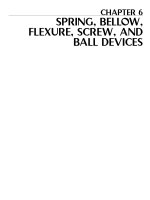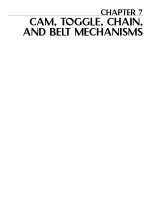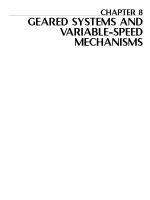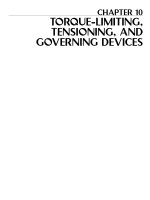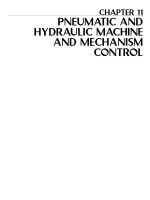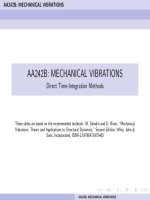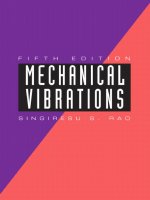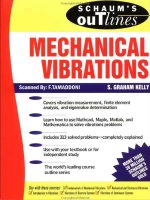Rao mechanical vibrations 5th txtbk
Bạn đang xem bản rút gọn của tài liệu. Xem và tải ngay bản đầy đủ của tài liệu tại đây (38.38 MB, 1,105 trang )
Mechanical
Vibrations
Fifth Edition
Singiresu S. Rao
University of Miami
Prentice Hall
Upper Saddle River Boston Columbus San Francisco New York
Indianapolis London Toronto Sydney Singapore Tokyo Montreal
Dubai Madrid Hong Kong Mexico City Munich Paris Amsterdam Cape Town
A01_RAO08193_05_SE_FM.QXD 8/21/10 12:25 PM Page i
Vice President and Editorial Director, ECS:
Marcia J. Horton
Senior Acquisitions Editor: Tacy Quinn
Editorial Assistant: Coleen McDonald
Senior Managing Editor: Scott Disanno
Production Liason: Irwin Zucker
Production Editor: Sangeetha Parthasarathy,
Laserwords
Senior Operations Specialist: Alan Fischer
Operations Specialist: Lisa McDowell
Senior Marketing Manager: Tim Galligan
Marketing Assistant: Mack Patterson
Art Director: Jayne Conte
Cover Designer: Suzanne Behnke
Art Editor: Greg Dulles
Media Editor: Daniel Sandin
Full-Service Project Management/Composition:
Laserwords Private Limited, Chennai, India.
Prentice Hall
is an imprint of
www.pearsonhighered.com
10 9 8 7 6 5 4 3 2 1
ISBN13: 978-0-13-212819-3
ISBN 10: 0-13-212819-5
Copyright © 2011, 2004 Pearson Education, Inc., publishing as Prentice Hall, 1 Lake Street, Upper Saddle
River, NJ 07458.
All rights reserved. Manufactured in the United States of America. This publication is protected by Copyright,
and permission should be obtained from the publisher prior to any prohibited reproduction, storage in a
retrieval system, or transmission in any form or by any means, electronic, mechanical, photocopying,
recording, or likewise. To obtain permission(s) to use material from this work, please submit a written request
to Pearson Education, Inc., Permissions Department, imprint permissions address.
MATLAB is a registered trademark of The Math Works, Inc., 3 Apple Hill Drive, Natick, MA 01760-2098
Many of the designations by manufacturers and seller to distinguish their products are claimed as trademarks.
Where those designations appear in this book, and the publisher was aware of a trademark claim, the
designations have been printed in initial caps or all caps.
The author and publisher of this book have used their best efforts in preparing this book. These efforts include
the development, research, and testing of the theories and programs to determine their effectiveness. The author
and publisher make no warranty of any kind, expressed or implied, with regard to these programs or the
documentation contained in this book. The author and publisher shall not be liable in any event for incidental
or consequential damages in connection with, or arising out of, the furnishing, performance, or use of these
programs.
Library of Congress Cataloging-in-Publication Data
Rao, S. S.
Mechanical vibrations / Singiresu S. Rao. 5th ed.
p. cm.
Includes index.
ISBN 978-0-13-212819-3 (978-0-13-212819-3 : alk. paper) 1. Vibration. I. Title.
TA355.R37 2010
620.3 dc22 2010028534
A01_RAO08193_05_SE_FM.QXD 8/21/10 12:25 PM Page ii
To Lord Sri Venkateswara
A01_RAO08193_05_SE_FM.QXD 8/21/10 12:25 PM Page iii
Preface xi
Acknowledgments xv
List of Symbols xvi
CHAPTER 1
Fundamentals of Vibration 1
1.1 Preliminary Remarks 2
1.2 Brief History of the Study of Vibration 3
1.2.1 Origins of the Study of Vibration 3
1.2.2 From Galileo to Rayleigh 6
1.2.3 Recent Contributions 9
1.3 Importance of the Study of Vibration 10
1.4 Basic Concepts of Vibration 13
1.4.1 Vibration 13
1.4.2 Elementary Parts of
Vibrating Systems 13
1.4.3 Number of Degrees of Freedom 14
1.4.4 Discrete and Continuous Systems 16
1.5 Classification of Vibration 16
1.5.1 Free and Forced Vibration 17
1.5.2 Undamped and Damped Vibration 17
1.5.3 Linear and Nonlinear Vibration 17
1.5.4 Deterministic and
Random Vibration 17
1.6 Vibration Analysis Procedure 18
1.7 Spring Elements 22
1.7.1 Nonlinear Springs 23
1.7.2 Linearization of a
Nonlinear Spring 25
1.7.3 Spring Constants of Elastic Elements 27
1.7.4 Combination of Springs 30
iv
1.7.5 Spring Constant Associated with the
Restoring Force due to Gravity 39
1.8 Mass or Inertia Elements 40
1.8.1 Combination of Masses 40
1.9 Damping Elements 45
1.9.1 Construction of Viscous Dampers 46
1.9.2 Linearization of a
Nonlinear Damper 52
1.9.3 Combination of Dampers 52
1.10 Harmonic Motion 54
1.10.1 Vectorial Representation of
Harmonic Motion 56
1.10.2 Complex-Number Representation
of Harmonic Motion 57
1.10.3 Complex Algebra 58
1.10.4 Operations on Harmonic Functions 59
1.10.5 Definitions and Terminology 62
1.11 Harmonic Analysis 64
1.11.1 Fourier Series Expansion 64
1.11.2 Complex Fourier Series 66
1.11.3 Frequency Spectrum 67
1.11.4 Time- and Frequency-Domain
Representations 68
1.11.5 Even and Odd Functions 69
1.11.6 Half-Range Expansions 71
1.11.7 Numerical Computation
of Coefficients 72
1.12 Examples Using MATLAB 76
1.13 Vibration Literature 80
Chapter Summary 81
References 81
Review Questions 83
Problems 87
Design Projects 120
Contents
A01_RAO08193_05_SE_FM.QXD 8/21/10 12:25 PM Page iv
CONTENTSv
CHAPTER 2
Free Vibration of Single-Degree-of-Freedom
Systems 124
2.1 Introduction 126
2.2 Free Vibration of an Undamped
Translational System 129
2.2.1 Equation of Motion Using Newton
s
Second Law of Motion 129
2.2.2 Equation of Motion Using Other
Methods 130
2.2.3 Equation of Motion of a Spring-Mass
System in Vertical Position 132
2.2.4 Solution 133
2.2.5 Harmonic Motion 134
2.3 Free Vibration of an Undamped
Torsional System 146
2.3.1 Equation of Motion 147
2.3.2 Solution 148
2.4 Response of First Order Systems
and Time Constant 151
2.5 Rayleigh
s Energy Method 153
2.6 Free Vibration with Viscous Damping 158
2.6.1 Equation of Motion 158
2.6.2 Solution 158
2.6.3 Logarithmic Decrement 164
2.6.4 Energy Dissipated in Viscous
Damping 166
2.6.5 Torsional Systems with Viscous
Damping 168
2.7 Graphical Representation of Characteristic Roots
and Corresponding Solutions 174
2.7.1 Roots of the Characteristic Equation 174
2.7.2 Graphical Representation of Roots and
Corresponding Solutions 175
2.8 Parameter Variations and Root Locus
Representations 176
2.8.1 Interpretations of and
in s-plane 176
2.8.2 Root Locus and Parameter
Variations 179
2.9 Free Vibration with Coulomb Damping 185
2.9.1 Equation of Motion 186
2.9.2 Solution 187
2.9.3 Torsional Systems with Coulomb
Damping 190
tv
n
, v
d
, z,
2.10 Free Vibration with Hysteretic Damping 192
2.11 Stability of Systems 198
2.12 Examples Using MATLAB 202
Chapter Summary 208
References 209
Review Questions 209
Problems 214
Design Projects 256
CHAPTER 3
Harmonically Excited Vibration 259
3.1 Introduction 261
3.2 Equation of Motion 261
3.3 Response of an Undamped System
Under Harmonic Force 263
3.3.1 Total Response 267
3.3.2 Beating Phenomenon 267
3.4 Response of a Damped System Under
Harmonic Force 271
3.4.1 Total Response 274
3.4.2 Quality Factor and Bandwidth 276
3.5 Response of a Damped System
Under 278
3.6 Response of a Damped System Under the
Harmonic Motion of the Base 281
3.6.1 Force Transmitted 283
3.6.2 Relative Motion 284
3.7 Response of a Damped System Under Rotating
Unbalance 287
3.8 Forced Vibration with Coulomb Damping 293
3.9 Forced Vibration with Hysteresis Damping 298
3.10 Forced Motion with Other Types of
Damping 300
3.11 Self-Excitation and Stability Analysis 301
3.11.1 Dynamic Stability Analysis 301
3.11.2 Dynamic Instability Caused by Fluid
Flow 305
3.12 Transfer-Function Approach 313
3.13 Solutions Using Laplace Transforms 317
3.14 Frequency Transfer Functions 320
3.14.1 Relation Between the General Transfer
function T(s) and the Frequency Transfer
Function 322
3.14.2 Representation of Frequency-Response
Characteristics 323
T(iv)
F(t) = F
0
e
iVt
A01_RAO08193_05_SE_FM.QXD 8/21/10 12:25 PM Page v
viCONTENTS
3.15 Examples Using MATLAB 326
Chapter Summary 332
References 332
Review Questions 333
Problems 336
Design Projects 362
CHAPTER 4
Vibration Under General Forcing
Conditions 363
4.1 Introduction 364
4.2 Response Under a General
Periodic Force 365
4.2.1 First-Order Systems 366
4.2.2 Second-Order Systems 372
4.3 Response Under a Periodic Force
of Irregular Form 378
4.4 Response Under a Nonperiodic Force 380
4.5 Convolution Integral 381
4.5.1 Response to an Impulse 382
4.5.2 Response to a General Forcing
Condition 385
4.5.3 Response to Base Excitation 386
4.6 Response Spectrum 394
4.6.1 Response Spectrum for Base
Excitation 396
4.6.2 Earthquake Response Spectra 399
4.6.3 Design Under a Shock
Environment 403
4.7 Laplace Transform 406
4.7.1 Transient and Steady-State
Responses 406
4.7.2 Response of First-Order Systems 407
4.7.3 Response of Second-Order Systems 409
4.7.4 Response to Step Force 414
4.7.5 Analysis of the Step Response 420
4.7.6 Description of Transient
Response 421
4.8 Numerical Methods 428
4.8.1 Runge-Kutta Methods 429
4.9 Response to Irregular Forcing Conditions Using
Numerical Methods 431
4.10 Examples Using MATLAB 436
Chapter Summary 440
References 440
Review Questions 441
Problems 444
Design Projects 465
CHAPTER 5
Two-Degree-of-Freedom Systems 467
5.1 Introduction 468
5.2 Equations of Motion for Forced
Vibration 472
5.3 Free Vibration Analysis of an Undamped
System 474
5.4 Torsional System 483
5.5 Coordinate Coupling and Principal
Coordinates 488
5.6 Forced-Vibration Analysis 494
5.7 Semidefinite Systems 497
5.8 Self-Excitation and Stability
Analysis 500
5.9 Transfer-Function Approach 502
5.10 Solutions Using Laplace Transform 504
5.11 Solutions Using Frequency Transfer
Functions 512
5.12 Examples Using MATLAB 515
Chapter Summary 522
References 523
Review Questions 523
Problems 526
Design Projects 552
CHAPTER 6
Multidegree-of-Freedom Systems 553
6.1 Introduction 555
6.2 Modeling of Continuous Systems as Multidegree-
of-Freedom Systems 555
6.3 Using Newton
s Second Law to Derive Equations
of Motion 557
6.4 Influence Coefficients 562
6.4.1 Stiffness Influence Coefficients 562
6.4.2 Flexibility Influence Coefficients 567
6.4.3 Inertia Influence Coefficients 572
6.5 Potential and Kinetic Energy Expressions in
Matrix Form 574
6.6 Generalized Coordinates and Generalized
Forces 576
6.7 Using Lagrange
s Equations to Derive Equations
of Motion 577
A01_RAO08193_05_SE_FM.QXD 8/21/10 12:25 PM Page vi
CONTENTSvii
6.8 Equations of Motion of Undamped Systems in
Matrix Form 581
6.9 Eigenvalue Problem 583
6.10 Solution of the Eigenvalue Problem 585
6.10.1 Solution of the Characteristic
(Polynomial) Equation 585
6.10.2 Orthogonality of Normal Modes 591
6.10.3 Repeated Eigenvalues 594
6.11 Expansion Theorem 596
6.12 Unrestrained Systems 596
6.13 Free Vibration of Undamped Systems 601
6.14 Forced Vibration of Undamped Systems Using
Modal Analysis 603
6.15 Forced Vibration of Viscously Damped
Systems 610
6.16 Self-Excitation and Stability Analysis 617
6.17 Examples Using MATLAB 619
Chapter Summary 627
References 627
Review Questions 628
Problems 632
Design Project 653
CHAPTER 7
Determination of Natural Frequencies and
Mode Shapes 654
7.1 Introduction 655
7.2 Dunkerley
s Formula 656
7.3 Rayleigh
s Method 658
7.3.1 Properties of Rayleigh
s Quotient 659
7.3.2 Computation of the Fundamental Natural
Frequency 661
7.3.3 Fundamental Frequency of Beams and
Shafts 663
7.4 Holzer
s Method 666
7.4.1 Torsional Systems 666
7.4.2 Spring-Mass Systems 669
7.5 Matrix Iteration Method 670
7.5.1 Convergence to the Highest Natural
Frequency 672
7.5.2 Computation of Intermediate Natural
Frequencies 673
7.6 Jacobi
s Method 678
7.7 Standard Eigenvalue Problem 680
7.7.1 Choleski Decomposition 681
7.7.2 Other Solution Methods 683
7.8 Examples Using MATLAB 683
Chapter Summary 686
References 686
Review Questions 688
Problems 690
Design Projects 698
CHAPTER 8
Continuous Systems 699
8.1 Introduction 700
8.2 Transverse Vibration of a String or
Cable 701
8.2.1 Equation of Motion 701
8.2.2 Initial and Boundary Conditions 703
8.2.3 Free Vibration of a Uniform
String 704
8.2.4 Free Vibration of a String with Both Ends
Fixed 705
8.2.5 Traveling-Wave Solution 709
8.3 Longitudinal Vibration of a Bar or Rod 710
8.3.1 Equation of Motion
and Solution 710
8.3.2 Orthogonality of Normal
Functions 713
8.4 Torsional Vibration of a Shaft or Rod 718
8.5 Lateral Vibration of Beams 721
8.5.1 Equation of Motion 721
8.5.2 Initial Conditions 723
8.5.3 Free Vibration 723
8.5.4 Boundary Conditions 724
8.5.5 Orthogonality of Normal
Functions 726
8.5.6 Forced Vibration 730
8.5.7 Effect of Axial Force 732
8.5.8 Effects of Rotary Inertia and Shear
Deformation 734
8.5.9 Other Effects 739
8.6 Vibration of Membranes 739
8.6.1 Equation of Motion 739
8.6.2 Initial and Boundary Conditions 741
8.7 Rayleigh
s Method 742
8.8 The Rayleigh-Ritz Method 745
8.9 Examples Using MATLAB 748
Chapter Summary 751
References 751
A01_RAO08193_05_SE_FM.QXD 8/21/10 12:25 PM Page vii
viiiCONTENTS
Review Questions 753
Problems 756
Design Project 768
CHAPTER 9
Vibration Control 769
9.1 Introduction 770
9.2 Vibration Nomograph and Vibration
Criteria 771
9.3 Reduction of Vibration at the Source 775
9.4 Balancing of Rotating Machines 776
9.4.1 Single-Plane Balancing 776
9.4.2 Two-Plane Balancing 779
9.5 Whirling of Rotating Shafts 785
9.5.1 Equations of Motion 785
9.5.2 Critical Speeds 787
9.5.3 Response of the System 788
9.5.4 Stability Analysis 790
9.6 Balancing of Reciprocating Engines 792
9.6.1 Unbalanced Forces Due to Fluctuations in
Gas Pressure 792
9.6.2 Unbalanced Forces Due to Inertia of the
Moving Parts 793
9.6.3 Balancing of Reciprocating
Engines 796
9.7 Control of Vibration 798
9.8 Control of Natural Frequencies 798
9.9 Introduction of Damping 799
9.10 Vibration Isolation 801
9.10.1 Vibration Isolation System with Rigid
Foundation 804
9.10.2 Vibration Isolation System with Base
Motion 814
9.10.3 Vibration Isolation System with Flexible
Foundation 821
9.10.4 Vibration Isolation System with Partially
Flexible Foundation 822
9.10.5 Shock Isolation 824
9.10.6 Active Vibration Control 827
9.11 Vibration Absorbers 832
9.11.1 Undamped Dynamic Vibration
Absorber 833
9.11.2 Damped Dynamic Vibration
Absorber 840
9.12 Examples Using MATLAB 843
Chapter Summary 851
References 851
Review Questions 853
Problems 855
Design Project 869
CHAPTER 10
Vibration Measurement and
Applications 870
10.1 Introduction 871
10.2 Transducers 873
10.2.1 Variable Resistance Transducers 873
10.2.2 Piezoelectric Transducers 876
10.2.3 Electrodynamic Transducers 877
10.2.4 Linear Variable Differential Transformer
Transducer 878
10.3 Vibration Pickups 879
10.3.1 Vibrometer 881
10.3.2 Accelerometer 882
10.3.3 Velometer 886
10.3.4 Phase Distortion 888
10.4 Frequency-Measuring Instruments 890
10.5 Vibration Exciters 892
10.5.1 Mechanical Exciters 892
10.5.2 Electrodynamic Shaker 893
10.6 Signal Analysis 895
10.6.1 Spectrum Analyzers 896
10.6.2 Bandpass Filter 897
10.6.3 Constant-Percent Bandwidth and
Constant-Bandwidth Analyzers 898
10.7 Dynamic Testing of Machines
and Structures 900
10.7.1 Using Operational Deflection-Shape
Measurements 900
10.7.2 Using Modal Testing 900
10.8 Experimental Modal Analysis 900
10.8.1 The Basic Idea 900
10.8.2 The Necessary Equipment 900
10.8.3 Digital Signal Processing 903
10.8.4 Analysis of Random Signals 905
10.8.5 Determination of Modal Data
from Observed Peaks 907
10.8.6 Determination of Modal Data
from Nyquist Plot 910
10.8.7 Measurement of Mode Shapes 912
10.9 Machine
Condition Monitoring
and Diagnosis 915
A01_RAO08193_05_SE_FM.QXD 8/21/10 12:25 PM Page viii
CONTENTSix
10.9.1 Vibration Severity Criteria 915
10.9.2 Machine Maintenance Techniques 915
10.9.3 Machine
Condition Monitoring
Techniques 916
10.9.4 Vibration Monitoring Techniques 918
10.9.5 Instrumentation Systems 924
10.9.6 Choice of Monitoring Parameter 924
10.10 Examples Using MATLAB 925
Chapter Summary 928
References 928
Review Questions 930
Problems 932
Design Projects 938
CHAPTER 11
Numerical Integration Methods in
Vibration Analysis 939
11.1 Introduction 940
11.2 Finite Difference Method 941
11.3 Central Difference Method for Single-Degree-of-
Freedom Systems 942
11.4 Runge-Kutta Method for Single-Degree-of-
Freedom Systems 945
11.5 Central Difference Method for Multidegree-of-
Freedom Systems 947
11.6 Finite Difference Method for Continuous
Systems 951
11.6.1 Longitudinal Vibration of Bars 951
11.6.2 Transverse Vibration of Beams 955
11.7 Runge-Kutta Method for Multidegree-of-
Freedom Systems 960
11.8 Houbolt Method 962
11.9 Wilson Method 965
11.10 Newmark Method 968
11.11 Examples Using MATLAB 972
Chapter Summary 978
References 978
Review Questions 979
Problems 981
CHAPTER 12
Finite Element Method 987
12.1 Introduction 988
12.2 Equations of Motion of an Element 989
12.3 Mass Matrix, Stiffness Matrix, and Force
Vector 991
12.3.1 Bar Element 991
12.3.2 Torsion Element 994
12.3.3 Beam Element 995
12.4 Transformation of Element Matrices and
Vectors 998
12.5 Equations of Motion of the Complete System of
Finite Elements 1001
12.6 Incorporation of Boundary
Conditions 1003
12.7 Consistent- and Lumped-Mass Matrices 1012
12.7.1 Lumped-Mass Matrix for a Bar
Element 1012
12.7.2 Lumped-Mass Matrix for a Beam
Element 1012
12.7.3 Lumped-Mass Versus Consistent-Mass
Matrices 1013
12.8 Examples Using MATLAB 1015
Chapter Summary 1019
References 1019
Review Questions 1020
Problems 1022
Design Projects 1034
Chapters 13 and 14 are provided as downloadable
files on the Companion Website.
CHAPTER 13
Nonlinear Vibration 13-1
13.1 Introduction 13-2
13.2 Examples of Nonlinear Vibration Problems 13-3
13.2.1 Simple Pendulum 13-3
13.2.2 Mechanical Chatter, Belt Friction
System 13-5
13.2.3 Variable Mass System 13-5
13.3 Exact Methods 13-6
13.4 Approximate Analytical Methods 13-7
13.4.1 Basic Philosophy 13-8
13.4.2 Lindstedt
s Perturbation Method 13-10
13.4.3 Iterative Method 13-13
13.4.4 Ritz-Galerkin Method 13-17
13.5 Subharmonic and Superharmonic
Oscillations 13-19
13.5.1 Subharmonic Oscillations 13-20
13.5.2 Superharmonic Oscillations 13-23
13.6 Systems with Time-Dependent Coefficients
(Mathieu Equation) 13-24
A01_RAO08193_05_SE_FM.QXD 8/21/10 12:25 PM Page ix
13.7 Graphical Methods 13-29
13.7.1 Phase-Plane Representation 13-29
13.7.2 Phase Velocity 13-34
13.7.3 Method of Constructing
Trajectories 13-34
13.7.4 Obtaining Time Solution from Phase
Plane Trajectories 13-36
13.8 Stability of Equilibrium States 13-37
13.8.1 Stability Analysis 13-37
13.8.2 Classification of Singular
Points 13-40
13.9 Limit Cycles 13-41
13.10 Chaos 13-43
13.10.1 Functions with Stable Orbits 13-45
13.10.2 Functions with Unstable Orbits 13-45
13.10.3 Chaotic Behavior of Duffing
s Equation
Without the Forcing Term 13-47
13.10.6 Chaotic Behavior of Duffing
s Equation
with the Forcing Term 13-50
13.11 Numerical Methods 13-52
13.12 Examples Using MATLAB 13-53
Chapter Summary 13-62
References 13-62
Review Questions 13-64
Problems 13-67
Design Projects 13-75
CHAPTER 14
Random Vibration 14-1
14.1 Introduction 14-2
14.2 Random Variables and Random Processes 14-3
14.3 Probability Distribution 14-4
14.4 Mean Value and Standard Deviation 14-6
14.5 Joint Probability Distribution of Several
Random Variables 14-7
14.6 Correlation Functions of a Random Process 14-9
14.7 Stationary Random Process 14-10
14.8 Gaussian Random Process 14-14
14.9 Fourier Analysis 14-16
14.9.1 Fourier Series 14-16
14.9.2 Fourier Integral 14-19
14.10 Power Spectral Density 14-23
14.11 Wide-Band and Narrow-Band Processes 14-25
14.12 Response of a Single-Degree-of-
Freedom System 14-28
14.12.1 Impulse-Response Approach 14-28
14.12.2 Frequency-Response Approach 14-30
14.12.3 Characteristics of the Response
Function 14-30
14.13 Response Due to Stationary Random
Excitations 14-31
14.13.1 Impulse-Response Approach 14-32
14.13.2 Frequency-Response Approach 14-33
14.14 Response of a Multidegree-of-Freedom
System 14-39
14.15 Examples Using MATLAB 14-46
Chapter Summary 14-49
References 14-49
Review Questions 14-50
Problems 14-53
Design Project 14-61
APPENDIX A
Mathematical Relationships and Material
Properties
1036
APPENDIX B
Deflection of Beams and Plates
1039
APPENDIX C
Matrices
1041
APPENDIX D
Laplace Transform
1048
APPENDIX E
Units
1056
APPENDIX F
Introduction to MATLAB
1059
Answers to Selected Problems1069
Index1077
xCONTENTS
A01_RAO08193_05_SE_FM.QXD 8/21/10 12:25 PM Page x
Preface
Changes in this Edition
This book serves as an introduction to the subject of vibration engineering at the undergraduate level. Favorable
reactions by professors and students to the fourth edition have encouraged me to prepare this fifth edition of the
book. I have retained the style of the prior editions, presenting the theory, computational aspects, and applications
of vibration in as simple a manner as possible, and emphasizing computer techniques of analysis. Expanded expla-
nations of the fundamentals are given, emphasizing physical significance and interpretation that build upon previ-
ous experiences in undergraduate mechanics. Numerous examples and problems are used to illustrate principles
and concepts.
In this edition some topics are modified and rewritten, many new topics are added and several new features
have been introduced. Most of the additions and modifications were suggested by users of the text and by reviewers.
Important changes include the following:
1. Chapter outline and learning objectives are stated at the beginning of each chapter.
2. A chapter summary is given at the end of each chapter.
3. The presentation of some of the topics is modified for expanded coverage and better clarity. These topics
include the basic components of vibrationspring elements, damping elements and mass or inertia elements,
vibration isolation, and active vibration control.
4. Many new topics are presented in detail with illustrative examples. These include the response of first-order
systems and time constant, graphical representation of characteristic roots and solutions, parameter variations
and root locus representation, stability of systems, transfer-function approach for forced-vibration problems,
Laplace transform approach for the solution of free- and forced-vibration problems, frequency transfer-function
approach, Bode diagram for damped single-degree-of-freedom systems, step response and description of
transient response, and inelastic and elastic impacts.
5. I have added 128 new examples, 160 new problems, 70 new review questions, and 107 new illustrations.
6. The C++ and Fortran program-based examples and problems given at the end of every chapter in the pre-
vious edition have been deleted.
Features of the Book
Each topic in Mechanical Vibrations is self-contained, with all concepts fully explained and the derivations
presented in complete detail.
Computational aspects are emphasized throughout the book. MATLAB-based examples as well as sev-
eral general-purpose MATLAB programs with illustrative examples are given in the last section of every
xi
A01_RAO08193_05_SE_FM.QXD 8/21/10 12:25 PM Page xi
chapter. Numerous problems requiring the use of MATLAB or MATLAB programs (given in the text) are
included at the end of every chapter.
Certain topics are presented in a somewhat unconventional mannerin particular, the topics of Chapters
9, 10 and 11. Most textbooks discuss isolators, absorbers, and balancing in different chapters. Since one of
the main purposes of the study of vibrations is to control vibration response, all topics related to vibration
control are given in Chapter 9. The vibration-measuring instruments, along with vibration exciters, exper-
imental modal analysis procedure, and machine-condition monitoring, are presented together in Chapter 10.
Similarly, all the numerical integration methods applicable to single- and multidegree-of-freedom systems,
as well as continuous systems, are unified in Chapter 11.
Specific features include the following:
More than 240 illustrative examples are given to accompany most topics.
More than 980 review questions are included to help students in reviewing and testing their understand-
ing of the text material. The review questions are in the form of multiple-choice questions, questions with
brief answers, true-false questions, questions involving matching of related descriptions, and fill-in-the-
blank type questions.
An extensive set of problems in each chapter emphasizes a variety of applications of the material cov-
ered in that chapter. In total there are more than 1150 problems. Solutions are provided in the instruc-
tors manual.
More than 30 design project-type problems, many with no unique solution, are given at the end of vari-
ous chapters.
More than 25 MATLAB programs are included to aid students in the numerical implementation of the
methods discussed in the text.
Biographical information about 20 scientists and engineers who contributed to the development of the
theory of vibrations is presented on the opening pages of chapters and appendixes.
MATLAB programs given in the book, answers to problems, and answers to review questions can be
found at the Companion Website, www.pearsonhighered.com/rao. The Solutions Manual with solutions
to all problems and hints to design projects is available to instructors who adopt the text for their courses.
Units and Notation
Both the SI and the English system of units are used in the examples and problems. A list of symbols, along with
the associated units in SI and English systems, appears after the Acknowledgments. A brief discussion of SI units
as they apply to the field of vibrations is given in Appendix E. Arrows are used over symbols to denote column
vectors, and square brackets are used to indicate matrices.
Organization of Material
Mechanical Vibrations is organized into 14 chapters and 6 appendixes. Chapters 13 and 14 are provided as down-
loadable files on the Companion Website. The reader is assumed to have a basic knowledge of statics, dynamics,
strength of materials, and differential equations. Although some background in matrix theory and Laplace trans-
form is desirable, an overview of these topics is given in Appendixes C and D, respectively.
Chapter 1 starts with a brief discussion of the history and importance of vibrations. The modeling of practical
systems for vibration analysis along with the various steps involved in vibration analysis are discussed. A description
is given of the elementary parts of a vibrating systemstiffness, damping, and mass (inertia). The basic concepts and
xiiPREFACE
A01_RAO08193_05_SE_FM.QXD 8/21/10 12:25 PM Page xii
PREFACExiii
terminology used in vibration analysis are introduced. The free-vibration analysis of single-degree-of-freedom
undamped and viscously damped translational and torsional systems is given in Chapter 2. The graphical repre-
sentation of characteristic roots and corresponding solutions, the parameter variations, and root locus representa-
tions are discussed. Although the root locus method is commonly used in control systems, its use in vibration is
illustrated in this chapter. The response under Coulomb and hysteretic damping is also considered. The undamped
and damped responses of single-degree-of-freedom systems to harmonic excitations are considered in Chapter 3.
The concepts of force and displacement transmissibilities and their application in practical systems are outlined.
The transfer-function approach, the Laplace transform solution of forced-vibration problems, the frequency-
response and the Bode diagram are presented.
Chapter 4 is concerned with the response of a single-degree-of-freedom system under general forcing
function. The roles of Fourier series expansion of a periodic function, convolution integral, Laplace trans-
form, and numerical methods are outlined with illustrative examples. The specification of the response of an
underdamped system in terms of peak time, rise time, and settling time is also discussed. The free and forced
vibration of two-degree-of-freedom systems is considered in Chapter 5. The self-excited vibration and sta-
bility of the system are discussed. The transfer-function approach and the Laplace transform solution of
undamped and dampled systems are also presented with illustrative examples. Chapter 6 presents the vibra-
tion analysis of multidegree-of-freedom systems. Matrix methods of analysis are used for presentation of the
theory. The modal analysis procedure is described for the solution of forced-vibration problems in this chap-
ter. Several methods of determining the natural frequencies and mode shapes of discrete systems are outlined
in Chapter 7. The methods of Dunkerley, Rayleigh, Holzer, Jacobi, and matrix iteration are discussed with
numerical examples.
While the equations of motion of discrete systems are in the form of ordinary differential equations, those
of continuous or distributed systems are in the form of partial differential equations. The vibration analysis of
continuous systems, including strings, bars, shafts, beams, and membranes, is given in Chapter 8. The method
of separation of variables is presented for the solution of the partial differential equations associated with con-
tinuous systems. The Rayleigh and Rayleigh-Ritz methods of finding the approximate natural frequencies are
also described with examples. Chapter 9 discusses the various aspects of vibration control, including the prob-
lems of elimination, isolation, and absorption. The vibration nomograph and vibration criteria which indicate
the acceptable levels of vibration are also presented. The balancing of rotating and reciprocating machines and
the whirling of shafts are considered. The active control techniques are also outlined for controlling the response
of vibrating systems. The experimental methods used for vibration-response measurement are considered in
Chapter 10. Vibration-measurement hardware and signal analysis techniques are described. Machine-condition
monitoring and diagnosis techniques are also presented.
Chapter 11 presents several numerical integration techniques for finding the dynamic response of discrete and
continuous systems. The central difference, Runge-Kutta, Houbolt, Wilson, and Newmark methods are discussed
and illustrated. Finite element analysis, with applications involving one-dimensional elements, is discussed in
Chapter 12. Bar, rod, and beam elements are used for the static and dynamic analysis of trusses, rods under tor-
sion, and beams. The use of consistent- and lumped-mass matrices in the vibration analysis is also discussed in
this chapter. Nonlinear vibration problems are governed by nonlinear differential equations and exhibit phenom-
ena that are not predicted or even hinted at by the corresponding linearized problems. An introductory treatment
of nonlinear vibration, including a discussion of subharmonic and superharmonic oscillations, limit cycles, sys-
tems with time-dependent coefficients, and chaos, is given in Chapter 13. The random vibration of linear vibration
systems is considered in Chapter 14. The concepts of random process, stationary process, power spectral density,
autocorrelation, and wide- and narrow-band processes are explained. The random vibration response of single- and
multidegree-of-freedom systems is discussed in this chapter.
A01_RAO08193_05_SE_FM.QXD 8/21/10 12:25 PM Page xiii
Appendixes A and B focus on mathematical relationships and deflection of beams and plates, respectively.
The basics of matrix theory, Laplace transform, and SI units are presented in Appendixes C, D, and E, respectively.
Finally, Appendix F provides an introduction to MATLAB programming.
Typical Syllabi
The material of the book provides flexible options for different types of vibration courses. Chapters 1 through 5,
Chapter 9, and portions of Chapter 6 constitute a basic course in mechanical vibration. Different emphases/orien-
tations can be given to the course by covering, additionally, different chapters as indicated below:
Chapter 8 for continuous or distributed systems.
Chapters 7 and 11 for numerical solutions.
Chapter 10 for experimental methods and signal analysis.
Chapter 12 for finite element analysis.
Chapter 13 for nonlinear analysis.
Chapter 14 for random vibration.
Alternatively, in Chapters 1 through 14, the text has sufficient material for a one-year sequence of two vibra-
tion courses at the senior or dual level.
Expected Course Outcomes
The material presented in the text helps achieve some of the program outcomes specified by ABET (Accreditation
Board for Engineering and Technology):
Ability to apply knowledge of mathematics, science, and engineering:
The subject of vibration, as presented in the book, applies knowledge of mathematics (differential equa-
tions, matrix algebra, vector methods, and complex numbers) and science (statics and dynamics) to solve
engineering vibration problems.
Ability to identify, formulate, and solve engineering problems:
Numerous illustrative examples, problems for practice, and design projects help the student identify various
types of practical vibration problems and develop mathematical models, analyze, solve to find the response,
and interpret the results.
Ability to use the techniques, skills, and modern engineering tools necessary for engineering practice:
The application of the modern software, MATLAB, for the solution of vibration problems is illustrated
in the last section of each chapter. The basics of MATLAB programming are summarized in Appendix F.
The use of the modern analysis technique, the finite element method, for the solution of vibration prob-
lems is covered in a separate chapter (Chapter 12). The finite element method is a popular technique
used in industry for the modeling, analysis, and solution of complex vibrating systems.
Ability to design and conduct experiments, as well as to analyze and interpret data:
The experimental methods and analysis of data related to vibration are presented in Chapter 10. Discussed
also are the equipment used in conducting vibration experiments, signal analysis and identification of sys-
tem parameters from the data.
xivPREFACE
A01_RAO08193_05_SE_FM.QXD 8/21/10 12:25 PM Page xiv
Acknowledgments
I would like to express my appreciation to the many students, researchers and faculty whose comments have helped
me improve the book. I am most grateful to the following people for offering their comments, suggestions, and ideas:
Ara Arabyan, University of Arizona; Daniel Granger, Polytechnic School of Montreal, Canada; K.M. Rao,
V.R.S. Engineering College Vijayawada, India; K. S. Shivakumar Aradhya, Gas Turbine Research Establishment,
Bangalore, India; Donald G. Grant, University of Maine; Tom Thornton, Stress Analyst: Alejandro J. Rivas,
Arizona State University; Qing Guo, University of Washington; James M. Widmann, California Polytechnic State
University; G. Q. Cai, Florida Atlantic University; Richard Alexander, Texas A & M University; C. W. Bert,
University of Oklahoma; Raymond M. Brach, University of Notre Dame; Alfonso Diaz-Jimenez, Universidad
Distrital Francisco Jose de Caldas, Colombia; George Doyle, University of Dayton; Hamid Hamidzadeh, South
Dakota State University; H. N. Hashemi, Northeastern University; Zhikun Hou, Worchester Polytechnic Institute;
J. Richard Houghton, Tennessee Technological University; Faryar Jabbari, University of California, Irvine; Robert
Jeffers, University of Connecticut; Richard Keltie, North Carolina State University; J. S. Lamancusa, Pennsylvania
State University; Harry Law, Clemson University; Robert Leonard, Virginia Polytechnic Institute and State
University; James Li, Columbia University; Sameer Madanshetty, Boston University; Masoud Mojtahed, Purdue
University, Calumet; Faissal A. Moslehy, University of Central Florida; M. G. Prasad, Stevens Institute of
Technology; Mohan D. Rao, Michigan Tech; Amir G. Rezaei, California State Polytechnic University; F. P. J.
Rimrott, University of Toronto; Subhash Sinha, Auburn University; Daniel Stutts, University of Missouri-Rolla;
Massoud Tavakoli, Georgia Institute of Technology; Theodore Terry, Lehigh University; David F. Thompson,
University of Cincinnati; Chung Tsui, University of Maryland, College Park; Alexander Vakakis, University of
Illinois, Urbana Champaign; Chuck Van Karsen, Michigan Technological University; Aleksandra Vinogradov,
Montana State University; K. W. Wang, Pennsylvania State University; Gloria J. Wiens, University of Florida; and
William Webster, GMI Engineering and Management Institute.
I would like to thank Purdue University for granting me permission to use the Boilermaker Special in Problem
2.104. My sincere thanks to Dr. Qing Liu for helping me write some of the MATLAB programs. Finally, I wish to
thank my wife, Kamala, without whose patience, encouragement, and support this edition might never have been
completed.
SINGIRESU S. RAO
xv
A01_RAO08193_05_SE_FM.QXD 8/21/10 12:25 PM Page xv
xvi
List of Symbols
Symbol Meaning English Units SI Units
constants, lengths
flexibility coefficient in./lb m/N
[a] flexibility matrix in./lb m/N
A area
constants
constants, lengths
constants
balancing weight lb N
c, viscous damping coefficient lb-sec/in.
constants
c wave velocity in./sec m/s
critical viscous damping constant lb-sec/in.
damping constant of i th damper lb-sec/in.
damping coefficient lb-sec/in.
[c] damping matrix lb-sec/in.
constants
d diameter, dimension in. m
D diameter in. m
[D] dynamical matrix
e base of natural logarithms
e eccentricity in. m
unit vectors parallel to x and y directions
E Young
s modulus Pa
E[x] expected value of x
f linear frequency Hz Hz
f force per unit length lb/in. N/m
unit impulse lb-sec
force lb N
amplitude of force F(t) lb NF
0
F, F
d
N
#
sf
'
, f
lb/in
2
e
!
x
, e
!
y
s
2
sec
2
C, C
1
, C
2
, C
1
, C
2
N
#
s/m
N
#
s/mc
ij
N
#
s/mc
i
N
#
s/mc
c
c, c
0
, c
1
, c
2
, Á
N
#
s/mc
'
B
!
B, B
1
, B
2
, Á
b, b
1
, b
2
, Á
A, A
0
, A
1
, Á
m
2
in
2
a
ij
a, a
0
, a
1
, a
2
, Á
A01_RAO08193_05_SE_FM.QXD 8/21/10 12:25 PM Page xvi
Symbol Meaning English Units SI Units
force transmitted lb N
force acting on ith mass lb N
force vector lb N
impulse lb-sec
g acceleration due to gravity
g(t) impulse response function
G shear modulus
h hysteresis damping constant lb/in N/m
frequency response function
i
I area moment of inertia
[I] identity matrix
Im() imaginary part of ()
j integer
J polar moment of inertia
mass moment of inertia
k, spring constant lb/in. N/m
spring constant of i th spring lb/in. N/m
torsional spring constant lb-in/rad N-m/rad
stiffness coefficient lb/in. N/m
[k] stiffness matrix lb/in. N/m
length in. m
mass kg
i th mass kg
mass coefficient kg
[m] mass matrix kg
M mass kg
M bending moment lb-in.
torque lb-in.
amplitude of lb-in.
n an integer
n number of degrees of freedom
N normal force lb N
N total number of time steps
p pressure
p(x) probability density function of x
P(x) probability distribution function of x
P force, tension lb N
j th generalized coordinate
vector of generalized displacements
vector of generalized velocities
j th generalized force
r
radius vector in. mr
!
frequency ratio = v/v
n
Q
j
q
!
#
q
!
q
j
N/m
2
lb/in
2
N
#
mM
t
1t2M
t0
N
#
mM
t
, M
t1
, M
t2
, Á
N
#
m
lb-sec
2
/in.
lb-sec
2
/in.
lb-sec
2
/in.m
ij
lb-sec
2
/in.m
i
lb-sec
2
/in.m, m
'
l, l
i
k
ij
k
t
k
i
k
'
kg
#
m
2
lb-in./sec
2
J, J
0
, J
1
, J
2
, Á
m
4
in
4
m
4
in
4
1- 1
H1iv2
N/m
2
lb/in
2
m/s
2
in./sec
2
N
#
sF
'
, F
F
!
F
t
F
t
, F
T
LIST OF SYMBOLSxvii
A01_RAO08193_05_SE_FM.QXD 8/21/10 12:25 PM Page xvii
xviiiLIST OF SYMBOLS
Symbol Meaning English Units SI Units
Re( ) real part of ( )
autocorrelation function
R electrical resistance ohm ohm
R Rayleigh
s dissipation function lb-in/sec
R Rayleigh
s quotient
s root of equation, Laplace variable
acceleration, displacement, velocity spectrum
spectrum of x
t time sec s
ith time station sec s
T torque lb-in N-m
T kinetic energy in lb J
kinetic energy of ith mass in lb J
displacement, force transmissibility
an element of matrix [U]
axial displacement in. m
U potential energy in lb J
unbalanced weight lb N
[U] upper triangular matrix
linear velocity in./sec m/s
V shear force lb N
V potential energy in lb J
potential energy of i th spring in lb J
transverse deflections in. m
value of w at in. m
value of at in./sec m/s
nth mode of vibration
W weight of a mass lb N
W total energy in lb J
W transverse deflection in. m
value of W at in. m
W(x) a function of x
x, y, z cartesian coordinates, displacements in. m
value of x at in. m
value of at in./sec m/s
displacement of jth mass in. m
value of x at in. m
value of at in./sec m/s
homogeneous part of x(t) in. m
particular part of x(t) in. m
vector of displacements in. m
value of at in. m
value of at in./sec m/s
value of at m/s
2
in./sec
2
t = t
i
x
!
$
x
!
$
i
t = t
i
x
!
#
x
!
#
i
t = t
i
x
!
x
!
i
x
!
x
p
x
h
t = t
j
x
#
x
#
j
t = t
j
x
j
x
j
t = 0x
#
x
#
0
, x
#
102
t = 0x
0
, x102
t = t
i
W
i
w
n
t = 0w
#
w
#
0
t = 0w
0
w, w
1
, w
2
, v
i
V
i
v, v
0
U
!
U, U
i
u
ij
T
d
, T
f
T
i
t
i
S
x
1v2
S
a
, S
d
, S
v
1/s
2
1/sec
2
N
#
m/s
R1t2
A01_RAO08193_05_SE_FM.QXD 8/21/10 12:25 PM Page xviii
LIST OF SYMBOLSxix
Symbol Meaning English Units SI Units
i th mode
X amplitude of x(t) in. m
amplitude of in. m
i th modal vector in. m
i th component of j th mode in. m
[X] modal matrix in. m
r th approximation to a mode shape
y base displacement in. m
Y amplitude of y (t) in. m
z relative displacement, in. m
Z amplitude of z (t) in. m
mechanical impedance lb/in. N/m
angle, constant
angle, constant
hysteresis damping constant
specific weight
logarithmic decrement
deflections in. m
static deflection in. m
Kronecker delta
determinant
increment in F lb N
increment in x in. m
increment in time t sec s
energy dissipated in a cycle in lb J
a small quantity
strain
damping ratio
constant, angular displacement
ith angular displacement rad rad
value of at rad rad
value of at rad/sec rad/s
amplitude of rad rad
amplitude of rad rad
transformation matrix
viscosity of a fluid
coefficient of friction
expected value of x
mass density
loss factor
standard deviation of x
stress
period of oscillation, time, time constant sec st
N/m
2
lb/in
2
s
s
x
h
kg/m
3
lb-sec
2
/in
4
r
m
x
m
kg/m
#
slb-sec/in
2
m
[l]
s
2
sec
2
eigenvalue = 1/v
2
l
u
i
1t2
i
u1t2
t = 0u
#
u
#
0
t = 0uu
0
u
i
u
z
e
e
¢W
¢t
¢x
¢F
¢
d
ij
d
st
d
1
, d
2
, Á
d
N/m
3
lb/in
3
g
b
b
a
Z1iv2
x - y
X
!
r
X
i
1j2
X
!
1i2
x
j
1t2X
j
x
!
1i2
1t2
A01_RAO08193_05_SE_FM.QXD 8/21/10 12:25 PM Page xix
Symbol Meaning English Units SI Units
shear stress
angle, phase angle rad rad
phase angle in ith mode rad rad
frequency of oscillation rad/sec rad/s
ith natural frequency rad/sec rad/s
natural frequency rad/sec rad/s
frequency of damped vibration rad/sec rad/sv
d
v
n
v
i
v
f
i
f
N/m
2
lb/in
2
t
Subscripts
SymbolMeaning
cri
critical value
eqequivalent value
iith value
Lleft plane
maxmaximum value
ncorresponding to natural frequency
Rright plane
0specific or reference value
ttorsional
Operations
SymbolMeaning
1 2
#
d1 2
dt
1 2
$
d
2
1
2
dt
2
1
:
2
column vector ( )
[ ]matrix
[ ]
-1
inverse of [ ]
[ ]
T
transpose of [ ]
¢1 2
increment in ( )
l 1 2
Laplace transform of ( )
l
-1
1
2inverse Laplace transform of ( )
xxLIST OF SYMBOLS
A01_RAO08193_05_SE_FM.QXD 8/21/10 12:25 PM Page xx
Galileo Galilei (15641642), an Italian astronomer, philosopher, and professor
of mathematics at the Universities of Pisa and Padua, in 1609 became the first
man to point a telescope to the sky. He wrote the first treatise on modern dynam-
ics in 1590. His works on the oscillations of a simple pendulum and the vibration
of strings are of fundamental significance in the theory of vibrations.
(Courtesy of Dirk J. Struik, A Concise History of Mathematics (2nd rev. ed.), Dover
Publications, Inc., New York, 1948.)
C H A P T E R 1
Fundamentals
of Vibration
1
Chapter Outline
This chapter introduces the subject of vibrations in a relatively simple manner. It begins
with a brief history of the subject and continues with an examination of the importance
of vibration. The basic concepts of degrees of freedom and of discrete and continuous
systems are introduced, along with a description of the elementary parts of vibrating
Chapter Outline 1
Learning Objectives 2
1.1 Preliminary Remarks 2
1.2 Brief History of the Study of Vibration 3
1.3 Importance of the Study of Vibration 10
1.4 Basic Concepts of Vibration 13
1.5 Classification of Vibration 16
1.6 Vibration Analysis Procedure 18
1.7 Spring Elements 22
1.8 Mass or Inertia Elements 40
1.9 Damping Elements 45
1.10 Harmonic Motion 54
1.11 Harmonic Analysis 64
1.12 Examples Using MATLAB 76
1.13 Vibration Literature 80
Chapter Summary 81
References 81
Review Questions 83
Problems 87
Design Projects 120
M01_RAO8193_05_SE_C01.QXD 8/21/10 2:06 PM Page 1
2CHAPTER 1 FUNDAMENTALS OF VIBRATION
systems. The various classifications of vibrationnamely, free and forced vibration,
undamped and damped vibration, linear and nonlinear vibration, and deterministic and
random vibration are indicated. The various steps involved in vibration analysis of an
engineering system are outlined, and essential definitions and concepts of vibration are
introduced.
The concept of harmonic motion and its representation using vectors and complex
numbers is described. The basic definitions and terminology related to harmonic motion,
such as cycle, amplitude, period, frequency, phase angle, and natural frequency, are given.
Finally, the harmonic analysis, dealing with the representation of any periodic function in
terms of harmonic functions, using Fourier series, is outlined. The concepts of frequency
spectrum, time- and frequency-domain representations of periodic functions, half-range
expansions, and numerical computation of Fourier coefficients are discussed in detail.
Learning Objectives
After completing this chapter, the reader should be able to do the following:
*Describe briefly the history of vibration
*Indicate the importance of study of vibration
*Give various classifications of vibration
*State the steps involved in vibration analysis
*Compute the values of spring constants, masses, and damping constants
*Define harmonic motion and different possible representations of harmonic motion
*Add and subtract harmonic motions
*Conduct Fourier series expansion of given periodic functions
*Determine Fourier coefficients numerically using the MATLAB program
1.1
Preliminary Remarks
The subject of vibration is introduced here in a relatively simple manner. The chapter
begins with a brief history of vibration and continues with an examination of its impor-
tance. The various steps involved in vibration analysis of an engineering system are out-
lined, and essential definitions and concepts of vibration are introduced. We learn here that
all mechanical and structural systems can be modeled as mass-spring-damper systems. In
some systems, such as an automobile, the mass, spring and damper can be identified as
separate components (mass in the form of the body, spring in the form of suspension and
damper in the form of shock absorbers). In some cases, the mass, spring and damper do
not appear as separate components; they are inherent and integral to the system. For exam-
ple, in an airplane wing, the mass of the wing is distributed throughout the wing. Also, due
to its elasticity, the wing undergoes noticeable deformation during flight so that it can be
modeled as a spring. In addition, the deflection of the wing introduces damping due to rel-
ative motion between components such as joints, connections and support as well as inter-
nal friction due to microstructural defects in the material. The chapter describes the
M01_RAO8193_05_SE_C01.QXD 8/21/10 2:06 PM Page 2
1.2 BRIEF HISTORY OF THE STUDY OF VIBRATION3
modeling of spring, mass and damping elements, their characteristics and the combination
of several springs, masses or damping elements appearing in a system. There follows a pre-
sentation of the concept of harmonic analysis, which can be used for the analysis of gen-
eral periodic motions. No attempt at exhaustive treatment of the topics is made in Chapter
1; subsequent chapters will develop many of the ideas in more detail.
1.2
Brief History of the Study of Vibration
1.2.1
Origins of
the Study of
Vibration
People became interested in vibration when they created the first musical instruments, proba-
bly whistles or drums. Since then, both musicians and philosophers have sought out the rules
and laws of sound production, used them in improving musical instruments, and passed them
on from generation to generation. As long ago as 4000
B
.
C
. [1.1], music had become highly
developed and was much appreciated by Chinese, Hindus, Japanese, and, perhaps, the
Egyptians. These early peoples observed certain definite rules in connection with the art of
music, although their knowledge did not reach the level of a science.
Stringed musical instruments probably originated with the hunters bow, a weapon
favored by the armies of ancient Egypt. One of the most primitive stringed instruments, the
nanga, resembled a harp with three or four strings, each yielding only one note. An exam-
ple dating back to 1500
B
.
C
. can be seen in the British Museum. The Museum also exhibits
an 11-stringed harp with a gold-decorated, bull-headed sounding box, found at Ur in a
royal tomb dating from about 2600
B
.
C
. As early as 3000
B
.
C
., stringed instruments such
as harps were depicted on walls of Egyptian tombs.
Our present system of music is based on ancient Greek civilization. The Greek philoso-
pher and mathematician Pythagoras (582 507
B
.
C
.) is considered to be the first person to
investigate musical sounds on a scientific basis (Fig. 1.1). Among other things, Pythagoras
FIGURE 1.1Pythagoras. (Reprinted
with permission from L. E. Navia,
Pythagoras: An Annotated Bibliography,
Garland Publishing, Inc., New York, 1990).
M01_RAO8193_05_SE_C01.QXD 8/23/10 4:58 PM Page 3
4CHAPTER 1 FUNDAMENTALS OF VIBRATION
1 2 3
String
Weight
FIGURE 1.2Monochord.
conducted experiments on a vibrating string by using a simple apparatus called a mono-
chord. In the monochord shown in Fig. 1.2 the wooden bridges labeled 1 and 3 are fixed.
Bridge 2 is made movable while the tension in the string is held constant by the hanging
weight. Pythagoras observed that if two like strings of different lengths are subject to the
same tension, the shorter one emits a higher note; in addition, if the shorter string is half
the length of the longer one, the shorter one will emit a note an octave above the other.
Pythagoras left no written account of his work (Fig. 1.3), but it has been described by oth-
ers. Although the concept of pitch was developed by the time of Pythagoras, the relation
between the pitch and the frequency was not understood until the time of Galileo in the
sixteenth century.
Around 350
B
.
C
., Aristotle wrote treatises on music and sound, making observations
such as the voice is sweeter than the sound of instruments, and the sound of the flute is
sweeter than that of the lyre. In 320
B
.
C
., Aristoxenus, a pupil of Aristotle and a musician,
FIGURE 1.3Pythagoras as a musician. (Reprinted with permission from D. E. Smith, History
of Mathematics, Vol. I, Dover Publications, Inc., New York, 1958.)
M01_RAO8193_05_SE_C01.QXD 8/21/10 2:06 PM Page 4
